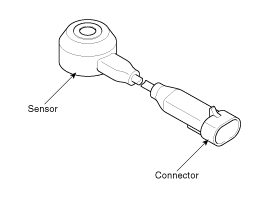 Hyundai Equus: Knock Sensor (KS) Description and Operation
Second generation VI (2009–2026) / Hyundai Equus VI 2009-2026 Service Manual / Engine Control/Fuel System / Engine Control System / Knock Sensor (KS) Description and Operation
Hyundai Equus: Knock Sensor (KS) Description and Operation
Second generation VI (2009–2026) / Hyundai Equus VI 2009-2026 Service Manual / Engine Control/Fuel System / Engine Control System / Knock Sensor (KS) Description and Operation
Second generation VI (2009–2026) / Hyundai Equus VI 2009-2026 Service Manual / Engine Control/Fuel System / Engine Control System / Knock Sensor (KS) Description and Operation
| Description |
Knocking is a phenomenon characterized by undesirable
vibration and noise and can cause engine damage. Knock Sensor (KS) is
installed on the cylinder block and senses engine knocking.
When knocking occurs, the vibration from the cylinder block
is applied as pressure to the piezoelectric element. When a knock
occurs, the sensor produces voltage signal. The ECM retards the ignition
timing when knocking occurs. If the knocking disappears after retarding
the ignition timing, the ECM will advance the ignition timing. This
sequential control can improve engine power, torque and fuel economy.

 Camshaft Position Sensor (CMPS) Repair procedures
Camshaft Position Sensor (CMPS) Repair procedures
Inspection
1.
Check the signal waveform of the CMPS and CKPS using the GDS.
Specification: Refer to “Wave Form”
Removal
•
DON’T remove the camshaft pos ...
 Knock Sensor (KS) Specifications
Knock Sensor (KS) Specifications
Specification
ItemSpecificationCapacitance (pF)950 ~ 1,350
...
See also:
Rear Driveshaft (VL-VL TYPE) Repair procedures
Replacement
1.
Loosen the wheel nuts slightly.
Raise the vehicle, and make sure it is securely supported.
2.
Remove the rear wheel and tire (A) from rear hub.
Be carefu ...
Locking
To lock :
1. Close all doors, engine hood and trunk.
2. Either press the door handle button or press the Door Lock button on the Smart
Key.
3. The hazard warning lights will blink and the chime ...
Relay Box (Engine Compartment) Repair procedures
Inspection
1.
Disconnect the negative (-) battery terminal.
2.
Pull out the relay from the engine compartment relay box.
Power Relay (Type A)
-
Do not use pliers.
...
Categories
Hyundai Equus Manuals
© 2011-2026 Copyright www.heqmanual.com
